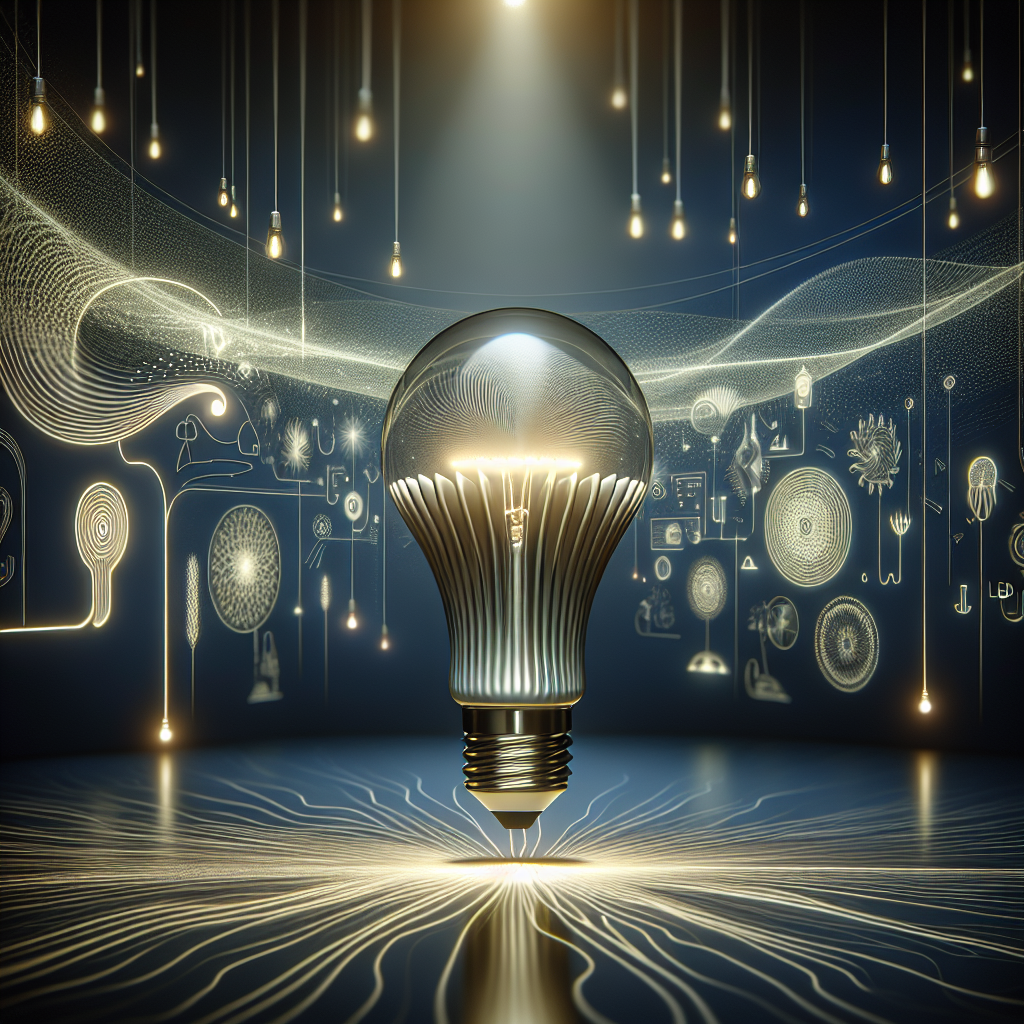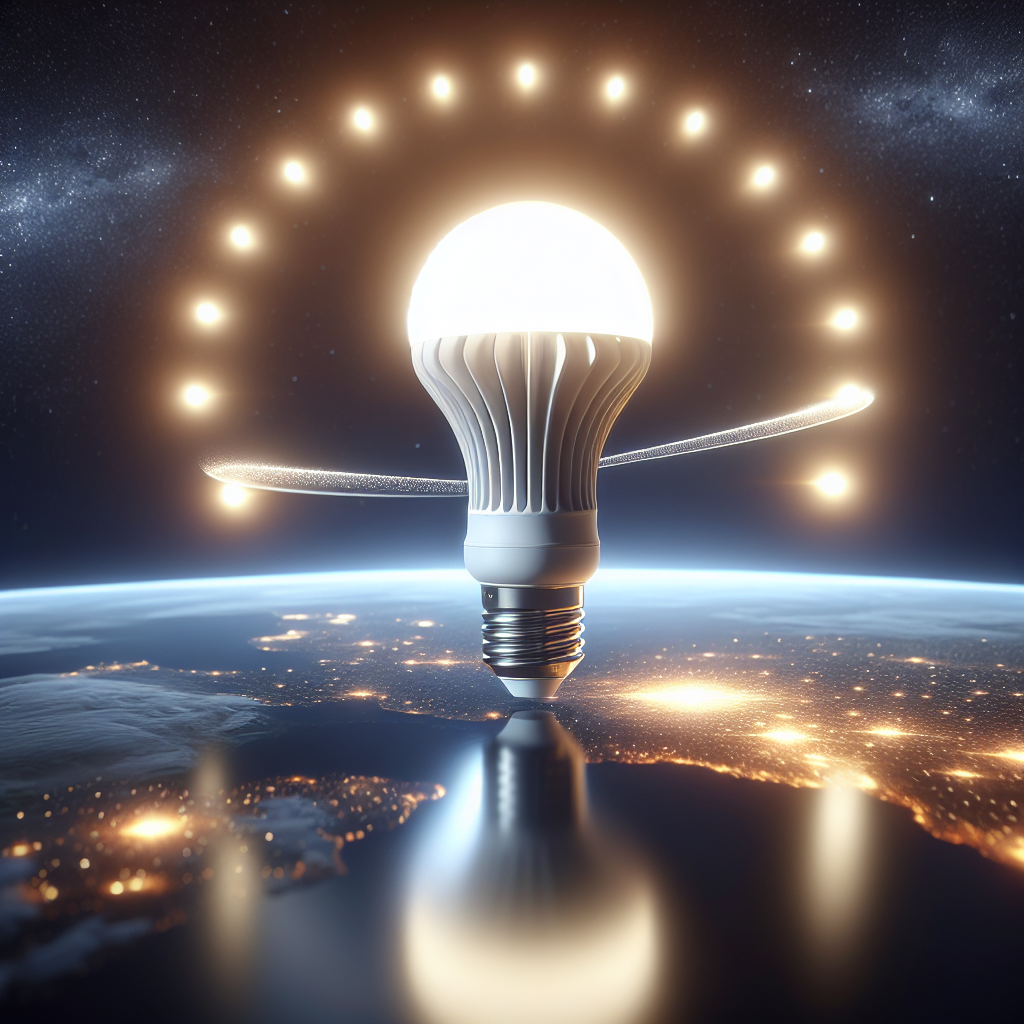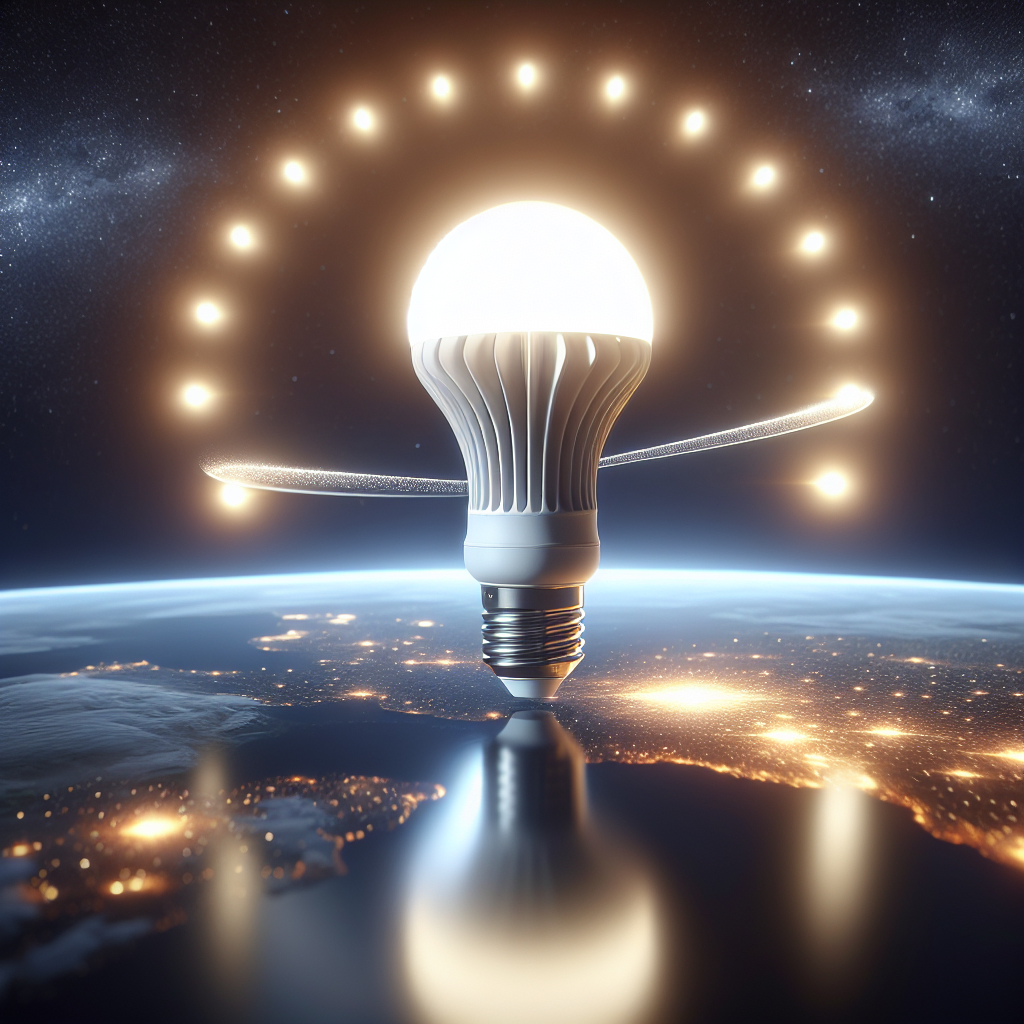Have you ever wondered how energy-efficient lighting works? In this article, we will explore the fascinating science behind this technology and discover the secrets behind its efficiency. From LED lights to smart lighting systems, we will dive into the intricate details of how these lights conserve energy and reduce environmental impact. Get ready to be enlightened as we unravel the science behind energy-efficient lighting.
How Does Energy-Efficient Lighting Work?
Light Emitting Diodes (LEDs)
LEDs, also known as light-emitting diodes, are a popular type of energy-efficient lighting. These small electronic devices emit light when an electrical current passes through them. Unlike traditional incandescent bulbs, which use a filament that glows to produce light, LEDs work by using a semiconductor material that emits light when activated. The specific semiconductor material used determines the color of the light produced. LEDs are highly efficient because they convert almost all of the electrical energy they receive into light, with very little wasted as heat.
Compact Fluorescent Lamps (CFLs)
Compact fluorescent lamps, or CFLs, are another type of energy-efficient lighting. These bulbs work by passing an electric current through a tube filled with mercury vapor and coated with phosphor. The electric current excites the mercury atoms, causing them to emit ultraviolet (UV) light. The phosphor coating on the tube absorbs this UV light and converts it into visible light. CFLs are more energy-efficient than traditional incandescent bulbs because they require less electrical energy to produce the same amount of light.
Halogen Incandescent Bulbs
Halogen incandescent bulbs are a variation of traditional incandescent bulbs that are more energy-efficient. These bulbs have a small amount of halogen gas inside them, which increases their efficiency and lifespan compared to traditional incandescent bulbs. Halogen incandescent bulbs work by passing an electric current through a tungsten filament, causing it to glow and emit light. The halogen gas in the bulb helps to recycle the tungsten, prolonging the life of the bulb.
Light-Optimizing Designs
In addition to the type of bulb used, the design of the lighting fixture itself can also contribute to energy efficiency. Light-optimizing designs help to direct the light where it is needed, reducing wasteful scattering and ensuring maximum illumination. This can be achieved through the use of reflectors, lenses, or diffusers, which control the direction and distribution of the light. By optimizing light distribution, energy-efficient lighting fixtures can provide the same level of illumination with lower energy consumption.
Advantages of Energy-Efficient Lighting
Lower Energy Consumption
One of the primary advantages of energy-efficient lighting is its lower energy consumption. Compared to traditional incandescent bulbs, energy-efficient lighting options such as LEDs, CFLs, and halogen incandescent bulbs use significantly less energy to produce the same amount of light. This translates to lower electricity bills and reduced energy demand, making energy-efficient lighting a cost-effective and environmentally friendly choice.
Longer Lifespan
Energy-efficient lighting options also have a longer lifespan compared to traditional incandescent bulbs. LEDs, for example, can last up to 25 times longer than incandescent bulbs. CFLs also have a significantly longer lifespan, lasting up to 10 times longer. This extended lifespan reduces the frequency of bulb replacement, providing further cost savings and convenience for users.
Reduced Environmental Impact
Another notable advantage of energy-efficient lighting is its reduced environmental impact. By consuming less energy, energy-efficient lighting options help to lower greenhouse gas emissions associated with electricity generation. Additionally, some energy-efficient bulbs, such as CFLs, contain lower levels of mercury compared to older fluorescent bulbs, reducing the potential environmental harm in case of accidental breakage or improper disposal.
Improved Safety
Energy-efficient lighting options contribute to improved safety. Traditional incandescent bulbs can become hot to the touch, posing a potential burn risk. In contrast, energy-efficient bulbs such as LEDs and CFLs operate at much lower temperatures, reducing the risk of burns or fire hazards. Additionally, the longer lifespan of energy-efficient bulbs means less frequent handling and replacement, reducing the risk of accidents or injuries.

Types of Energy-Efficient Lighting
LED Lighting
LED lighting is the most commonly recognized type of energy-efficient lighting. LEDs are available in various shapes, sizes, and colors, making them versatile for various lighting applications. They are often used in residential and commercial settings, including homes, offices, and outdoor lighting fixtures. LED lighting offers exceptional energy savings, long lifespan, and a wide range of color temperature options to suit different preferences and needs.
CFL Lighting
CFL lighting is another popular choice for energy-efficient lighting. These spiral-shaped bulbs provide excellent energy savings and can fit into most traditional light fixtures. CFLs are commonly used in homes and businesses where the lighting needs to be more affordable and energy-efficient. They are available in different shapes and sizes and provide a range of color temperatures, allowing users to select the desired ambiance for their space.
Halogen Incandescent Lighting
Halogen incandescent lighting provides an energy-efficient alternative to traditional incandescent bulbs. These bulbs offer improved energy efficiency and a longer lifespan compared to regular incandescent bulbs. Halogen incandescent bulbs are commonly used in track lighting, recessed lighting, and accent lighting applications. They provide a warm, crisp light that is ideal for highlighting specific areas or objects.
The Role of Light Emitting Diodes (LEDs)
Basic Operating Principles
LEDs operate based on the phenomenon of electroluminescence, where light is emitted from a material when an electric current is passed through it. The key component of an LED is the semiconductor chip, which is made from a combination of elements such as gallium, arsenic, and phosphorous. When a voltage is applied to the chip, electrons and holes recombine, releasing energy in the form of light.
Efficiency and Energy Savings
LEDs are highly efficient at converting electrical energy into light. They have a higher lumen-per-watt rating compared to traditional incandescent bulbs, which means they produce more light for the same amount of electricity consumed. This high efficiency leads to significant energy savings and lower utility bills. In fact, when compared to incandescent bulbs, LEDs can reduce energy consumption by up to 80%, making them a smart choice for energy-conscious individuals and businesses.
Color Temperature Options
LEDs offer a wide range of color temperature options, allowing users to customize the lighting ambiance to suit their needs. Color temperature is measured in Kelvin (K) and is categorized into three main groups: warm white (2700K-3500K), neutral white (3500K-5000K), and cool white/daylight (5000K-6500K). Warm white LEDs provide a cozy, yellowish light similar to traditional incandescent bulbs, while cool white LEDs emit a bright, bluish-white light often found in commercial or outdoor settings.
Directional Lighting
Another advantage of LEDs is their ability to provide directional lighting. Unlike traditional incandescent bulbs that emit light in all directions, LEDs emit light in a specific direction, which eliminates the need for reflectors or diffusers to control light distribution. This makes LEDs ideal for focused lighting applications, such as spotlights or task lighting, where precise illumination is required.

Understanding Compact Fluorescent Lamps (CFLs)
How CFLs Produce Light
CFLs produce light through a series of chemical reactions that occur inside the bulb. When electricity flows through the ballast, it stimulates the mercury vapor inside the CFL, causing it to emit ultraviolet (UV) light. The UV light then interacts with the phosphor coating on the inner surface of the bulb, causing it to fluoresce and emit visible light. The combination of the UV light and phosphor coating creates the characteristic glow associated with CFLs.
The Ballast: An Essential Component
A ballast is an essential component of CFLs. It regulates the electrical current flowing through the bulb and provides the necessary voltage to stimulate the mercury vapor and produce light. Without a ballast, the CFL bulb would not function properly. The ballast also helps to stabilize the current and prevent flickering or humming, ensuring a stable and consistent light output.
Mercury Content and Safety Precautions
CFLs contain a small amount of mercury, which is necessary for the production of light. While the mercury content in CFLs is relatively low, it is still important to handle and dispose of these bulbs properly. If a CFL breaks, it is recommended to avoid direct contact with the mercury and follow specific cleanup procedures provided by local authorities or the Environmental Protection Agency. Additionally, recycling programs are available for safe disposal of CFLs, reducing the potential environmental impact of mercury release.
CFL Lifespan Considerations
The lifespan of CFLs is influenced by several factors, including the number of times the bulb is turned on and off, the operating temperature, and the quality of the ballast. CFLs have a limited number of on/off cycles before their lifespan is significantly reduced, so they are better suited for applications where the light will be on for longer periods of time. When choosing CFLs, it is important to consider the intended usage and select bulbs with appropriate lifespan ratings to maximize their longevity.
Halogen Incandescent Bulbs: A Middle Ground
The Halogen Cycle
Halogen incandescent bulbs are a type of incandescent bulb that combines the features of traditional incandescent technology with improved energy efficiency. These bulbs use a tungsten filament enclosed in a small quartz envelope, which contains a small amount of halogen gas such as iodine or bromine. When the bulb is turned on, the tungsten filament heats up, releasing light. The halogen gas helps to recycle the tungsten back onto the filament, extending the bulb’s lifespan.
Increased Efficiency and Lifespan
Compared to traditional incandescent bulbs, halogen incandescent bulbs offer increased energy efficiency and a longer lifespan. The presence of the halogen gas allows the tungsten to be redeposited on the filament, reducing the rate of filament evaporation and extending the bulb’s lifespan. Halogen incandescent bulbs can also produce more light output for the same wattage compared to traditional incandescent bulbs, making them a more efficient lighting option.
Dimming Capabilities
Halogen incandescent bulbs have excellent dimming capabilities, making them ideal for creating different lighting levels and moods. Unlike some other energy-efficient lighting options, halogen incandescent bulbs can be dimmed without the need for additional equipment or special dimmers. This versatility allows users to adjust the lighting intensity to suit their preferences and create a cozy or ambient atmosphere.
Heat Output and Safety
Halogen incandescent bulbs are known to produce more heat compared to other energy-efficient lighting options such as LEDs or CFLs. While this can be a disadvantage in terms of energy efficiency, the heat output can be beneficial in certain applications. For example, in colder environments, the heat produced by halogen bulbs can help to maintain temperature, reducing the need for additional heating sources. However, it is important to use caution when handling halogen bulbs, as they can become very hot during operation.
Factors Affecting Energy-Efficient Lighting
Wattage and Lumens
The wattage and lumens of a light bulb are important factors to consider when choosing energy-efficient lighting. Wattage refers to the amount of electricity consumed by the bulb, while lumens measure the brightness or light output. Energy-efficient bulbs, such as LEDs and CFLs, generally have lower wattage and higher lumen output compared to traditional incandescent bulbs. By selecting bulbs with appropriate wattage and lumens, users can achieve the desired lighting levels while minimizing energy consumption.
Color Rendering Index (CRI)
The color rendering index (CRI) is a measure of how accurately a light source illuminates colors compared to natural light. CRI is especially important in settings where color accuracy is crucial, such as art galleries, retail stores, or photography studios. Energy-efficient lighting options, including LEDs and CFLs, typically have high CRI values, ensuring that colors appear vibrant and true to life.
Color Temperature
Color temperature refers to the perceived warmth or coolness of light and is measured in Kelvin (K). Lower color temperature values, such as 2700K-3500K, produce a warm, yellowish light similar to traditional incandescent bulbs. Higher color temperatures, such as 5000K-6500K, produce a cool, bluish-white light often associated with daylight. Energy-efficient lighting options offer a range of color temperature options, allowing users to select the desired ambiance and lighting effect for their space.
Lighting Controls
Lighting controls, such as dimmers, timers, or motion sensors, play a significant role in optimizing energy-efficient lighting. By incorporating lighting controls, users can customize the lighting levels based on their preferences and needs, resulting in additional energy savings. Dimmers allow for adjusting the brightness of light sources, timers can automate turning lights on and off, and motion sensors ensure lights are only activated when necessary. Proper utilization of lighting controls further enhances energy efficiency and convenience.
Calculating Energy Savings with Energy-Efficient Lighting
Determining Wattage and Usage
To calculate energy savings with energy-efficient lighting, it is necessary to determine the wattage of the existing bulbs and the anticipated usage. Begin by identifying the wattage of the traditional bulbs being replaced. Then, estimate the number of hours per day the bulbs are expected to be in use. Multiply the wattage by the number of hours to find the watt-hours consumed per day.
Estimating Cost Savings
Once the watt-hours consumed per day are determined, multiply that by the number of days the bulbs are used in a year to find the annual watt-hours consumed. To estimate cost savings, multiply the annual watt-hours by the local electricity rate to calculate the annual cost of lighting with the traditional bulbs. Repeat the process for the energy-efficient bulbs and compare the savings. Energy-efficient bulbs often result in significant cost savings due to their lower energy consumption.
Return on Investment
Calculating the return on investment (ROI) can provide further insight into the cost-effectiveness of energy-efficient lighting. To calculate ROI, subtract the cost of purchasing and installing the energy-efficient bulbs from the annual cost savings obtained from using these bulbs. Divide the result by the cost of the investment and multiply by 100 to obtain the ROI percentage. A positive ROI indicates that the investment in energy-efficient lighting is worthwhile and will lead to long-term cost savings.
Addressing Common Misconceptions
Expensive Upfront Costs
One common misconception about energy-efficient lighting is that it is more expensive upfront compared to traditional lighting options. While energy-efficient bulbs may have a higher purchase price, they offer significant long-term savings due to their energy efficiency and extended lifespan. These cost savings in energy consumption and bulb replacement far outweigh the slightly higher initial investment.
Limited Light Output
Another misconception is that energy-efficient lighting options, such as LEDs or CFLs, have limited light output compared to traditional bulbs. However, technological advancements have significantly improved the brightness and performance of energy-efficient bulbs. LEDs, in particular, are capable of providing high-quality, bright light that is comparable to or even surpasses the light output of traditional incandescent bulbs.
Health and Safety Concerns
Some individuals may have health and safety concerns regarding energy-efficient lighting. For example, there have been concerns about the blue light emitted by LEDs and its potential impact on sleep patterns. It is important to note that advancements in LED technology now allow for the customization of color temperature, including warm white options that have a less pronounced impact on circadian rhythms. Additionally, when used properly and safely, energy-efficient bulbs pose no greater health risks than traditional bulbs.
Disposal of Bulbs
Proper disposal of energy-efficient bulbs, particularly those containing mercury like CFLs, is essential to minimize potential environmental impact. Many communities have recycling programs in place for safe disposal of these bulbs. Additionally, advancements in bulb design have reduced the mercury content in CFLs, making them safer to handle and dispose of. By following local regulations and utilizing recycling programs, consumers can ensure responsible disposal of energy-efficient bulbs and minimize environmental harm.
Future Trends and Innovations
Smart Lighting Systems
The future of energy-efficient lighting lies in smart lighting systems. These systems integrate advanced technology, such as sensors, wireless connectivity, and automation, to create intelligent lighting solutions. Smart lighting systems can automatically adjust brightness based on natural light levels, occupancy, or user preferences, resulting in further energy savings. Additionally, these systems often include features that allow for remote control or scheduling, providing convenience and flexibility for users.
Connected and Controllable Lights
Connected and controllable lights are a key aspect of smart lighting systems. These lights can be wirelessly controlled and monitored using a smartphone, tablet, or voice commands. Users can adjust brightness, color temperature, or even create customized lighting scenes to suit their needs. The ability to control lights remotely provides convenience and enables users to optimize energy usage according to their preferences and requirements.
Advancements in LED Technology
LED technology continues to advance at a rapid pace, driving the adoption of energy-efficient lighting. Manufacturers are constantly developing new LED chips, materials, and production techniques to improve performance, efficiency, and lifespan. Advancements in chip designs have led to higher lumen output, improved color rendering, and greater energy savings. The ongoing development of LED technology ensures that energy-efficient lighting options will continue to evolve and provide even greater benefits in the future.
Integration with Renewable Energy Sources
The integration of energy-efficient lighting with renewable energy sources is an emerging trend. As renewable energy becomes more prevalent, it is increasingly feasible to power lighting systems with clean, sustainable energy sources such as solar or wind. By combining energy-efficient lighting with renewable energy, users can achieve even greater reductions in their carbon footprint and contribute to a more sustainable future.
In conclusion, energy-efficient lighting offers numerous advantages, including lower energy consumption, longer lifespan, reduced environmental impact, and improved safety. LEDs, CFLs, and halogen incandescent bulbs are some of the key options available, each with its unique benefits. Factors such as wattage, lumens, color temperature, and the use of lighting controls should be considered when selecting energy-efficient lighting. Additionally, calculating energy savings and addressing common misconceptions can help users make informed choices. Looking ahead, the future of energy-efficient lighting lies in smart lighting systems, connected lights, advancements in LED technology, and integration with renewable energy sources, leading to even greater energy efficiency and sustainability.

